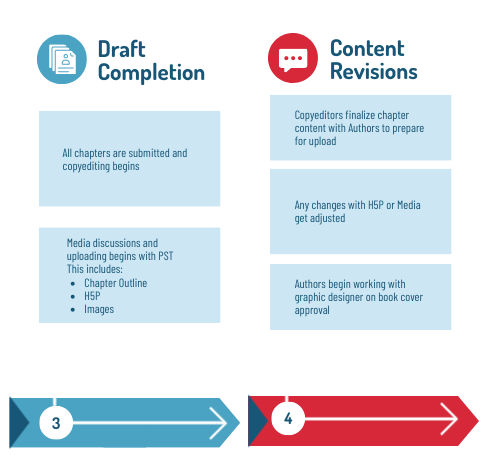Editing
The editing process for the ROTEL Grant starts with the completion of the draft by the author, and the editor works through one or two revisions of the content. Copy-editors work during the draft completion and content revision portions of the process, as pictured below.

Google Drive
Standard Policy
Throughout the ROTEL Grant, we worked within Google Drive, as it is a solid collaborative tool that had free and easy access for editing. We created and maintained a Google account for the purpose and created a file hierarchy and cataloguing system to ensure we could locate each project.
Rationale
Given the iterative process mentioned before, we decided it was important that the authors and Copy-Editors have conversations about the text and choices to be made.
Lessons Learned
Regular Editing: Any kind of authorship comes with the internal struggle of looking back over one’s work and determining changes they could make that would hopefully improve or clarify their writing. The system of working in Google Drive empowers writers to continue working on the current version that is being worked on by the members of the PST. For the purposes of publishing, this particular difficulty was the biggest contributor to version control throughout the entire process.
At the point of uploading the content to the publishing platform, when the content should become fixed as “final,” version control on this content. The PST had developed relationships with the authors and did not want to present any action that could be interpreted as antagonistic.
Style Guide
Standard Policy
All ROTEL publications have to meet the standards put forth by the Style Guide, which was provided to authors early in the process of writing.
Rationale
A style guide is best practice when putting together a collection of works under a single published series. This ensures standards of quality and consistency across all works.
Lessons Learned
Style Guide Revision: Omissions in the style guide led to multiple instances of repeated similar adjustments needed to be made to many of the books. We determined that we did not have the capacity to work on revisions to the Style Guide and make our deadlines, but we strongly encourage any other groups embarking on similar projects to ensure there is time to review standards of style and policy.
Reviewing the Standards with Authors: Because the authors are faculty members with many areas of responsibility, it is important to review items such as the style guide with them. Emails can get lost, wires can get crossed, and reference materials can be inadvertently tossed. An author may not have seen the style guide or had enough time to review it. Taking the time to walk through the style guide with the author, emphasizing any decisions they need to make, proved to be a helpful meeting to have.

